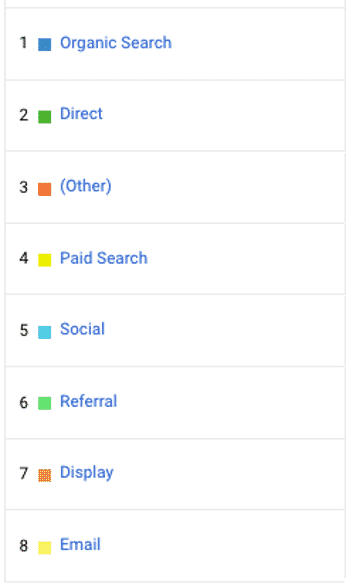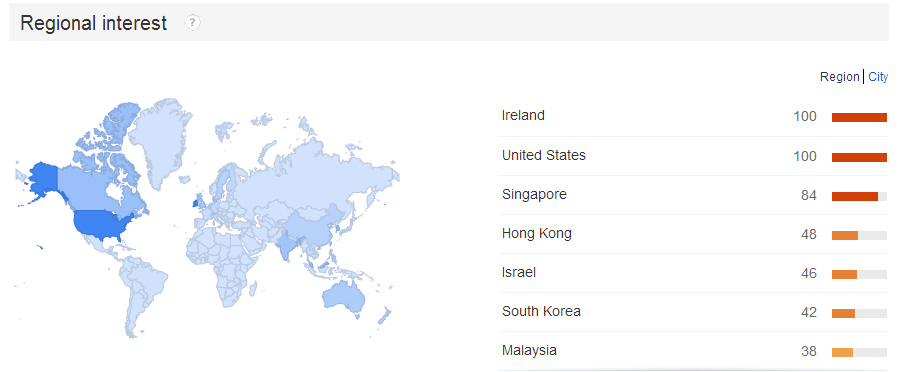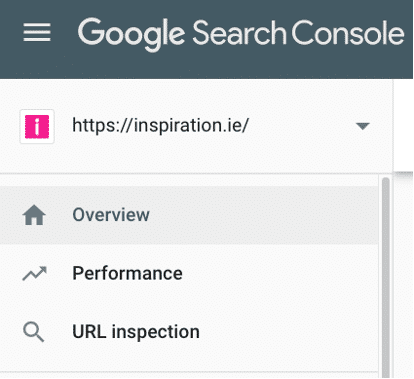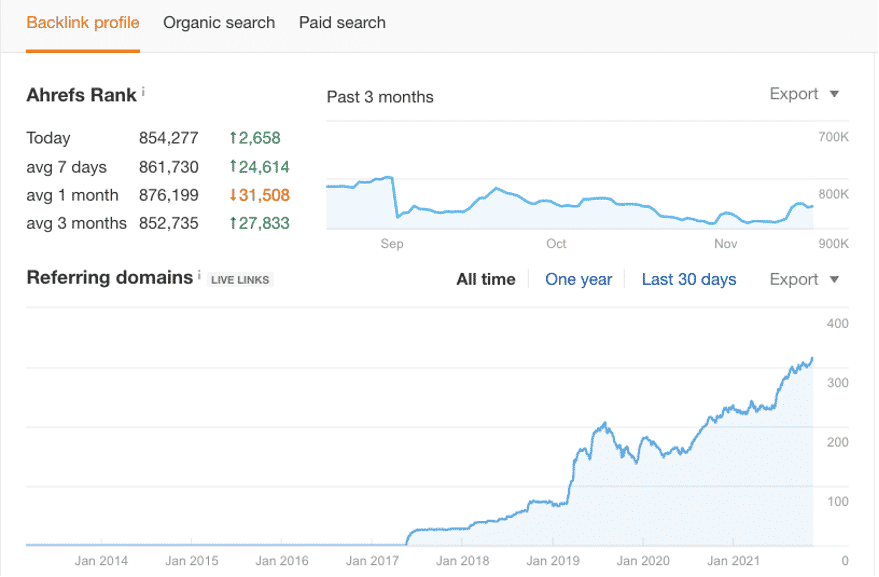This website uses cookies so that we can provide you with the best user experience possible. Cookie information is stored in your browser and performs functions such as recognising you when you return to our website and helping our team to understand which sections of the website you find most interesting and useful.
Many companies launch into their Digital Marketing Strategy process somewhat blind. Often they have little understanding of their competitive online landscape. They may not even have formulated online objectives or goals.
Should they engage with social media and if so, how? It’s important to invest the time and effort upfront in conducting proper research and planning. The digital marketing strategy and roll out plan will then be based on a sound footing.
We often find that digital marketing strategy sessions bleed into tactical discussions but let’s not get hung up on what’s a strategy and what’s a tactical plan .
Time’s short; you need to know where you are going online (strategy) and how you are going to get there (tactics). So in this section we’ll cover a practical overview of both aspects.
But first…
Ultimately the goal of marketing should be to help drive sales or make the ‘selling’ easier. The strategy and tactics of achieving this goal is going to vary greatly depending on the business (along with the timelines and sales cycles).
So get clued in on ‘What are the business goals’? If you know this, then that is going to determine your strategy and tactics. Digital Marketing is not something that happens in a vacuum away from the top-level business considerations. It needs to have a fundamental voice at the table.
So let’s say your business Goal for Quarter 3 in 2022 is to generate X euro in revenue. Now, with that top level goal in mind – you can move onto the strategy and then the tactics to make this business goal a reality.
But understand that marketing needs to be aware of the overall business goals.What are the Business Goals?
With that said..
In this section we’ll cover a practical overview of both aspects – Strategy and Tactics.

Strategy Snapshot
- Research and analyse your target market for your digital plan.
- Review your internal capabilities and outline your digital marketing goals.
- Research all aspects of your current online performance.
- Look at what your competitors are doing online.
- Lay out the key components of your digital marketing strategy.
- Document a roll out implementation plan.
The approach outlined here is based on Inspiration’s 22+ years of providing services such as web development, search engine optimisation, online marketing support, email marketing and content marketing. Our strategic approach has delivered many successful outcomes for our clients. We hope our expertise and insights will help you develop an effective Digital Marketing Strategy based on our already proven process.
Remember
A good digital marketing strategy is there to support a business plan – if the company doesn’t have a documented plan for the business, then how will you measure the success of the digital marketing strategy?
There are a number of areas upfront you will need to look at to inform your Strategic approach
- Target Audience Profile
- Your Online Readiness or Expertise
- Company Background Details

You need to identify clearly your target customer(s). Consider the following;
- Where is your target audience is physically located?
- What industry sectors are you targeting?
- Who makes purchasing decisions within your target companies?
- Who are the key influencers in your industry?
- Where are your target market likely to be found browsing online e.g. forums, industry sites, blogs?
- Who is your ideal ‘Buyer Persona’ or target customer?
- What websites have specific or indeed related trusted news about your industry?
- What keyterms is your target audience searching online? (more on this below)
- Do I have access to sales calls, Customer enquiries, Frequently asked Questions?
- Are my target audience leaving reviews online? If so, where?
- Is it possible to speak with my target audience?
This phase is critical. You really have to know your target audience (and customers) inside out. By studying the above – you are getting a deeper sense of what your target audience is looking for. What are their pain points? And how can your product or service address these?

This is a useful quick ‘snap shot’ exercise to gauge your own level of internet marketing expertise. This process will assess the different key areas of your existing web presence to identify your strengths and weaknesses (similar to a SWOT analysis).
- Look at your website’s current performance in terms of key traffic metrics (visits, bounce rates, enquiries, source of traffic, online sales etc.).
- Look at the extent to which your current website is optimised for search engines.
- Ask do you have a comprehensive content marketing strategy driving quality content on your website, through your social media accounts and online generally.
- What social media accounts are you active on and what is your approach to each platform.
- Are you engaged in regular email marketing?
These are the key pieces of background information to consider and document for your digital marketing strategy and plan.
- What are your specific online goals & Objectives:
- Grow relevant traffic from x to y by year end
- Improve search rankings e.g. to rank for a, b, c in 6 months
- Generate x % of new business online by June 2022
- Social Media – to have 5 daily active engagements on LinkedIn and Increase Twitter following by x%
- Grow brand exposure – measure direct traffic in Google Analytics and brand searches in Google Search Console.
- What are the companies Unique Selling Points?
- What messaging do we need to develop to communicate these USP’s clearly to our customers?
- What is your annual budget for digital marketing?
- What keywords do I think my target audience might be using online to find our products / services? Your partner can verify these and make recommendations based on actual search activity.
- Who are my top 5 – 10 competitors in the target market?
- What offline marketing activity is planned within the next year?
- What conversion metrics do I need to implement and track online e.g. completed enquiry forms, inbound calls initiated from a web search, downloads , email enquiry direct from an advertised website email address.
- What internal resources do I have available to work alongside my digital marketing strategy partner in the development and roll out of the digital strategy and roll out plan.
- What content do I think might interest my target audience in both the short and long term?
- What concerns / issues do my target audience have which could be addressed through a longer term ‘evergreen’ content strategy?
- What content do I already have available in-house which might be useful for ongoing marketing purposes?
- How are we currently promoting and distributing our content online – Social media? Third party sites? Paid Ads? Influencer Marketing?
By documenting your thoughts, insights and knowledge on the above 3 key areas upfront you will have identified a lot of the key data required for the Preliminary Research, Digital Marketing Strategy development and tactical planning phase.
There are a number of preliminary research areas to look at in preparing your Digital Marketing Strategy. You may not need all of these nor have the resources to research each area in detail. However the more information you have upfront the better informed your strategy will be.
There are also a variety of tools available to help you develop a more complete picture of your online landscape. We have linked to a few that may be useful in carrying out your research.
This research will also help you better prepare for the potential website development stage of your digital marketing strategy, whether you are building a replacement site or starting from scratch.
Key areas to focus on:

If you have an existing site with analytics implemented you can get an understanding of your existing target market, where they are located as well as their demographic profile. Google Trends can also give information about who is looking at particular search terms.
Search Engines form a core aspect of any modern digital marketing strategy. Google accounts for over 90% of the Search Engine market share in Europe. Luckily Google provide a range of tools for optimising and analysing your search engine marketing efforts.
Understanding the search terms that your potential customers will use to find your products and services is vital for your digital marketing strategy campaign. Google Keyword Planner is a great first step and very useful for determining keyword search volumes for geographical areas.
Another great tool is Keywords Everywhere. This chrome and Firefox extension can give you very quickly an idea of search volumes and other related search terms. You can purchase credits for $10 that will likely cover you for many months up to a year.

Another powerful tool to understand what your audience is searching for is the People Also Box within Google itself. You can use Also Asked to see these great questions that your target audience is searching.
Answer the Public functions in a very similar fashion but uses the autocomplete data from Google. Again this is very useful in understanding your audience and powering your content ideas.
There are other amazing paid tools such as Ahrefs and others that can share very helpful data like search terms.
Of course then, assuming your site is setup – there are the 2 big ones (for free): Google Search Console and Google Analytics. Google search console will show tons of queries that you’re ranking (and almost ranking for) in Google. As you can imagine – this gives great insight into what people are actually looking for.

Google Analytics can be linked to share this data from search console too. Plus, if you have a site-search function on your site – this can be tracked in Google Analytics to see exactly what people are looking for on your website.
Furthermore, if you have Google Ads setup – you can view the Keywords and search terms report to see exact specifics of what people search for also.
It’s important to use these tools to find the keywords that your potential customers & prospects are actually looking for online. The industry terms you “feel appropriate” may not be the actual ones your customers are physically using to search for your products and services. At the same time a large search volume for certain terms or keywords does not necessarily indicate those key words are optimal for your business. They might not be the most relevant terms to drive the right or most relevant prospects to your site.
For this reason – it’s good to do your research from a mix of sources and not depend just on keyword volume. There may be many ‘zero-search keywords’ that are actually valuable to your business.
Content refers to the words and images on your site as well as articles and information you might publish elsewhere on the internet. Use competitor analysis to see what strategies other businesses like yours have implemented in terms of content.
Quality Content is the engine that drives your Digital Marketing Strategy and ultimately the success of your web presence. It’s key to and at the heart of any Digital Marketing strategy.
That might mean a blog, a podcast, a YouTube channel.
It is easy to overlook content but it is critical you don’t.
By using tools such as Google Analytics and Google Search Console – you can see how your content has been performing. (We often see for clients with an existing site and ongoing content marketing in blogs – a content update often can bring great dividends. Whereas new sites with no prior content marketing will obviously need to focus on content creation to begin).

Following on from this – if SEO is a channel worth pursuing for you, understanding the playing field is a must. If you want to rank for any keyword – we recommend you google it first. The search engine results page (SERP) will tell you everything you need to know. What is Google rewarding for that keyterm? Is it Homepages or listicle articles? It’s critical that you meet the search intent with the right type of content. We recommend you take that data and pop it into a spreadsheet and look at titles, metadescriptions, H1, H2’s’s etc and ultimately make your content much much better.
Can you satisfy that search intent in a better way in respect to what’s already ranking? If you are using the Keywords Everywhere tool as above – you will be able to see also the Domain Authority for each site that’s ranking. This leads onto the next point.
The quality and number of links into your website are a significant factor in how search engines determine how to rank your website in their search results. (Domain Authority (DA) as above, is not ranking factor per se – but it a metric used to determine overall backlink authority which does greatly influence ranking). Building high quality links from trusted, authoritative and relevant sites is an important aspect of your digital marketing strategy

You can use tools such as Moz’s Open Site Explorer to see what sites and pages are currently linking into your own website. You can also use it to identify the back links of your competitors’ sites.
If your website has excessive poor quality backlinks or multiple backlinks using exact match anchor text your domain name may already have been penalised by Google. You may not have received an official warning from Google via webmaster tools but your website might have dropped in organic traffic over a certain time period.
You can use tools such as Ahrefs to see what sites and pages are currently linking into your own website. You can also use it to identify the back links of your competitors’ sites. Using Google Search Console is also another great place to start for understanding your incoming links. Other tools include SEO Review Tools and Moz’s Open Site Explorer
If your website has excessive poor quality backlinks or multiple backlinks using exact match anchor text your domain name that could be a red flag for Google. Ultimately you want quality and quantity. A typical analogy is that everything onsite – the content, tech fixes etc makes up the car but links is often the fuel to carry it forward.
Receiving links from trusted relevant websites is the ideal scenario. For this reason, it’s quality first and then quantity. Getting spammy links will not help your SEO performance.

Top Tip – We recommend using a combination of all tools to get a clear picture of your back link profile.

Social media can be a powerful channel in promoting your company, product and overall web presence. However choose the right platform(s). If your competition is not using a particular social media platform it maybe because their customers are not on it.
Find out what social media platforms your customers are using. While social media is not a ranking factor when it comes to ranking in Google, a successful social media strategy can help indirectly. If something is shared on social organically, it is more likely to be picked up and linked to! (Thus helping SEO).. But most importantly go to where your audience is present and active. Whether that’s TikTok, LinkedIn or Facebook groups– will depend on very much on your research.
On top of this – Social media can also be used to identify thought leaders and influencers in your sector.
Top Tip – While you absolutely can sell directly from social media – it generally is more of an ‘awareness’ channel. It’s great for building brand and educating potential customers. So be sure about where social media falls in your overall marketing mix. Other channels like Google Ads, SEO and Email can be more direct response and sales driven. But when you have a good brand – it’s a lot easier to sell.
Any information you can gather on your target markets is potentially invaluable. You can go direct to the source by using a free email survey platform like Survey Monkey. These provide easy to use templates to set up and distribute detailed customer surveys. Google Forms are another good option for creating simply surveys. You can also embed one easily into your website….

See the email marketing section for more information on building email lists. Try to offer recipients something in return for filling out the survey – incentivise it! This might be as simple as sending them a report on the survey results particularly if the information would also be useful to them.

Spend some time finding out where information is shared and distributed online within your industry or sector. This may include forums, blogs, online magazines and other social media channels. Determine if there are places where they overlap. Consider how you might effectively engage with and contribute to the conversations on these platforms and websites.
Spark Toro is one tool that you can use to find where your audience is paying attention.
To monitor your competitors’ search engine results performance you can either use tools like Ahrefs etc or do some straightforward searches in Google for your own industry, sector, product & service keywords. See who and what websites are ranking well for those keywords. Look at their websites, their content and online marketing approaches.
See what they are doing well and what you can potentially do to replicate or indeed leap frog their search results success. You may also identify linking opportunities or other websites you can ‘piggy back’ off i.e. quality link building opportunities, forums to participate on, and industry bodies to join. The list might also provide you with remarketing opportunities.
For content research – 2 Great websites include Quora and Reddit. There’s a decent chance there’s a conversation happening in your niche on there. Sites like these can help with keyword research as above and getting into the nitty gritty of a topic (and customer pain points)
Use software like WhatCMS to find out what you can about the different website platforms and content management systems available. Looking at competitor sites and websites with similar products or services can help you determine which might work best for your business.
Determine the optimal layout for your website navigation based on the site’s content and the type of product or service offering. An ecommerce site will typically have a distinctly different layout and navigation system to an IT services provider. Again, looking at competitor or similar sites can help to determine the best approach for your website.
On top of this make sure the site speed is up to scratch. Apart from it being a ranking factor for Google, it’s now a basic expectation in 2022 and beyond. You can use tools like GTmetrix and Page Speed Insights to see how your site and competitors shape up.
With your Strategic Business Goals in mind consider what calls to action are most appropriate for your website. Your calls to action may encompass phone us, email us, product downloads, video to watch, gallery views, content sharing opportunities etc. Your website should induce action from the visitor. This action should ultimately be some form of contact or engagement using one of the potential calls to action.
Here working with a professional copywriter can all make all the difference to your website’s conversion rate.
Your Digital Marketing Strategy document is a high level document that takes in broad areas of your business.
Checklist of Contents for your Digital Strategy Document:
Executive Summary
This should quickly and clearly outline the main actions of the plan and give an overview of the digital marketing strategy.
Target Audience
This should include all the information gathered on the target audience of the campaign, including demographic profiles and Buyer Personas
Competitor Analysis
Outline your main competitors – document their website performance, keyword focus, social media engagement and paid advertising approach.
Strategic Goals
List the goals of the digital marketing strategy. They should be clear, measurable and achievable.
Strategy Components
Outline which specific strategies, approaches and techniques will be used in your Digital Marketing approach.
Situational Analysis
This should outline an honest evaluation of the current status of the company’s online presence.
- How is the website performing in search results?
- What are the traffic levels and the sources of our website traffic?
- Does our website load quickly?
- How well is our website optimised for search engines?
- Is it designed responsively for mobile devices?
- Is our online marketing driven by an underlying content marketing plan?
- What is the current approach to social media platforms?
- What calls to action do we currently employ – are they appropriate?
- What is the current hosting set up and is it appropriate for our business?
Content Development Plan
Documenting the specific content approach to be taken, what it will include, resources to carry it out and an implementation plan.
Project Management
Establish responsibilities and ownership for each aspect of the project and timescales within which each element is to be completed.
Digital Marketing Channels
Which digital marketing channels will you focus on? E.g. Google Ads, SEO, email marketing or social media.
Having looked at your current website and the factors underlining its current performance it’s important to look at what your competitors are doing. We have prepared a detailed competitor research post on this key area on our own blog. By understanding what competitors are doing with their online marketing initiatives it will give you insights on areas for you to focus your attention to differentiate your business online.
The areas that we would recommend researching include:
- Web design and development – what platform are they using, what calls to action do they have on their site and why? What USPs and key messaging are they promoting?
- Keyword research focus – Knowing what keywords your competitors use in their Meta Titles, Descriptions and page content can help you identify their Keyword focus. Screaming Frog is a great free tool for this research.
- Content development and Content Marketing – content marketing is the key driver behind all online marketing activity so it’s important to understand this key area.
- SEO – Similar to content marketing -it’s vital to understand what your competitors are ranking for. Understanding what type of pages and keywords are driving traffic is a great place to start when it comes to SEO. Ahrefs is one of the best source’s to understand the what’s working in SEO for them. (Unless they are nice enough to share their Google Analytics and Google Search Console access with you -unlikely!)
- Social media approach – Social media can be a valuable source of website traffic as long as you are using appropriate platforms for your business. Researching your competitors’ social media profiles can not only help identity relevant platforms but also the different approaches to engagement on these platforms.
- Paid Advertising – Are your competitors using paid advertising such as Google Ads or social media ads to reach their target audience?
- (Here you can discover your Competitors Linkedin Ads and their Facebook and Instagram Ads). If your competitors are paying to appear for a certain keyword then it’s probably of value to them.. and maybe you also?
Laying out your Digital Marketing Strategy is relatively easy. The hard part is putting it into action. Planning is vital here. You need to ensure each step of the Strategy is accounted for, has a person made responsible, a time frame for completion and measurable metrics for each activity.
Some of the work will be done in-house and some may be done by your Digital Marketing Strategy bpartner. Document a month by month plan outlining who is responsible for each task. At the end of each month a call or meeting between all parties can be held to confirm what has been carried out, coordinate activities, highlight problems and plan the subsequent month.
This approach creates structure while leaving enough flexibility to accommodate the inevitable yet unforeseeable complications that arise.
For example, typically Inspiration will help our clients set up Social media profiles and syndicate it with content. However the day to day management of social media engagement is best done in house. Paid advertising is a specialist area and should ideally be outsourced to a specialist. Technical SEO is normally not a skill set that exists in-house. Content Marketing should be a shared activity between client and partner as it’s central to and drives all other digital marketing initiatives.
A roll out plan can take many forms. We believe in keeping this simple. The format is not important. It is important that the roll out plan identifies all the tasks to be completed, timing for implementation, person who will complete each one and the key metrics for measuring effectiveness of each component.
With the above info – you are well on your way to developing a digital marketing strategy and plan in 2022 and beyond. That said, let’s look in a little more detail the top 5 strategies that work today. (There are others of course but odds are these 5 more often that not make up the bulk of any Digital Marketing Strategy and plan)
**But remember every business is different. What works for your competitor may not be the wisest for you. Your budget, resources and crucially, where your audience are paying attention now and in the future are all going to shape the focus here.**
SEO is the digital marketing strategy of improving the visibility of a website or a web page in search engine results, through ensuring that sites and pages are easily discovered by both humans and search engines. (Google being the number one for most in Ireland)
Why use SEO?
It’s hard to think of a reason not to use SEO. As you will see – SEO is a direct effort but also a consequence of everything else.
SEO hits multiple levels of awareness
Some readers don’t know what they want yet. Others know exactly what they want and are ready to purchase today. Therefore these are going to be different searches and thus will likely require different types of content.
SEO gives you the opportunity to get in front of customers today (and the ones of tomorrow)
So whatever industry you’re in – there’s likely potential customers asking questions in search that need to be answered. And it might as well be you to answer them.
SEO is Free
Ok well not free in that it takes time and expertise. But every time someone clicks on your search result – you don’t pay a thing. Unlike PPC (more on this below)
Makes you easily identifiable
Even if it’s not going to be a focus for you in terms of content creation (more on this below).. at some point – a customer is going to google you. Therefore getting your brand out there will be vital.
PPC is digital marketing strategy which uses paid advertising to achieve digital marketing objectives. PPC ( an acronym for Pay Per Click), simply means that if someone clicks on your ad you are billed for it. Think of Google Ads, Linkedin Ads or Facebook ads.

Why Use PPC
You can get in front of your target audience immediately.
Unlike SEO, PPC is immediate. While we recommend waiting at least 2-4 weeks before judging any PPC campaign to gather data and insights – you can watch the results progress almost in Realtime. This is much quicker than SEO which tends to be a much longer term process.
Appear at the top of Google
You can leapfrog the organic listings and appear right at the top of the search results page (this is just for Google ads, needless to say).
Build Awareness
Paid social – think Linkedin, Facebook etc is a great way to reach your target audience too. While you can absolutely do this too with Google Ads – there is more of an emphasis on the creative here with videos and images.
Audience Segmentation
There are huge possibilities in both google display and paid social. You can get really granular in your advertising; making your message more personal and more likely to ‘convert’. Of course this all depends (as above) on knowing your target audience very well.
Google display
Google Display is great for brand awareness and remarketing (although remarketing will be more difficult in the short-medium term in a cookie-less world). Remarketing can be a great way to follow up with those potentially interested in your products and services that landed on your website.
A side note – Google Ads vs Paid Social
Google Ads tends to get more ‘conversions’. That could be calls, emails, contact forms, sales (depends on the site). But often, this is not the case for paid social ads.
Of course, there are many factors at play here like industry sales cycles.
(For example, you probably won’t purchase a €100,000 euro a year software based off 1 ad – but you very well might do that for a 30 euro product).
A core difference is that when someone clicks on your ad in google – they are actively searching for what you have to offer. So naturally, there’s a decent chance of a conversion – as the reader is in a state of awareness that’s more geared towards action.
But that’s not always the case with paid social. Yes, you can target the ideal persona – but when they are scrolling through their social feed – they are not actively searching for the product or service you provide.
That is the main difference (generally speaking).
So why bother with paid social? Just because they are not looking to buy today, does not mean they won’t be looking to buy at some point in the future. And if you have established your brand as an authoritative figure in your space – you’re much more likely to be the go-to option when they are ready to buy. Paid social can help cement this view and build your brand.
(Of course you can still convert directly from paid social – there are numerous variables at play that can affect the success of your social ads – the creative, copy, target audience, industry etc.)
Content marketing is focused on developing and sharing valuable digital content to attract and retain a clearly defined audience — and, ultimately, to drive profitable customer action. As a term, it’s sometimes used interchangeably with SEO. But overall this is a powerful part of your digital marketing strategy as content can do different things and hit different objectives.
Why use Content Marketing?
Brand building
The act of consistently showing up and creating quality content that your target audience and customers value – builds your brand greatly.
Hit different stages of the funnel
As above, you can create different types of content for different types of searches in Google. And thus target different searchers. But of course, not all content has to be created for search engines. Something very ‘bottom of funnel’ like a case-study will likely not have any searches – but it could be the perfect piece of content to convince a prospect of your credentials when they are on the site.
Boosts SEO
Writing related articles in your area helps clarify to Google what exactly your niche is. Plus content marketing can allow for internal linking and strategic anchor text – all boosting target pages. Likewise certain content can attract backlinks which can therefore raise all pages in search, including the more ‘salesy’ pages.
Longevity
If you are creating evergreen posts – this type of content can give you quality traffic year after year. Of course, you may need to update your content from time to time -but in principal – you have something that can be repurposed and reused.
Content can act as a ‘workhorse’
Whether you have a blog or a podcast – it’s not just 1 item by itself. A podcast can be transcribed into a blog post, a Youtube video. You can take different parts of it and use for different social media posts. Content marketing is great for distribution and feeding the next major machine of the next point; social media.
This doesn’t need to much of an intro. This is any platform from TikTok to Twitter. The question for you is what channel or channels (if any) best suits you and your business? But assuming, you’ve done your research as above – social can be a very powerful play for your business.
Why use Social Media?
Distribution Channel
It’s a great way to leverage and get more mileage out of your content marketing efforts. That evergreen blog be shared and reshared. Sliced and diced into smaller exerts can all make for great social posts.
Testing Ground
Some posts will flop. Others will do well. And others will really explode. Take note of what really is successful as this can be great inspiration for your next content marketing effort.
Builds Brand
Arguably this is the number 1 reason to be on social. You can of course still sell directly but its harder. Social media is an awareness channel that you can use to educate buyers and build your brand. And then when they are ready to buy – you are a leading contender for the business.
Indirectly Help SEO
Social media can get your content in front of more eyeballs and increase the chance of getting those coveted backlinks. Which of course are a major ranking factor to SEO.
This is the oldest digital marketing channel but still one of the best strategies to have in place for 2022. It is as you can imagine – emailing your customers and prospects directly.

Why use Email Marketing?
You own the Media
While the above is great – you are still to a degree at the mercy of the big players like Google or Facebook. Algorithms can change, organic reach can stop. Therefore it’s advisable to build your email list in tandem.
Nurture your leads
SEO and content marketing can be a great way to capture initial attention. But email is a great way to move your potential customers further down the marketing funnel – ie towards a purchase. Email marketing (when done right) can move someone from point A to B – ‘hhmm I’m curious, tell me more’ to ‘ok I’ll buy today!!’. An offer or a lead magnet in your content is a great way to build your email list.
It’s still a great channel to sell
Direct Response marketing is well suited to email. The copywriting in subject lines and body text is critical to success here. This makes email an excellent way to let your audience know about your offers.
Distribution Channel
Again it’s another place to share your content with your subscribers – all of which helps build brand loyalty.
Your Digital Marketing Strategy can be comprehensive but it doesn’t have to be complicated. Understanding your audience inside out will help you reverse engineer a lot of decisions and where to focus.
If you are ready to step your business up in 2022 (and join the other successful clients we’ve worked with) please get in touch with us.


